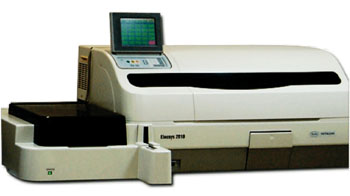Cardiac Biomarker Increase Associated with Higher Risk of Heart Disease
By LabMedica International staff writers
Posted on 30 Jun 2016
High-sensitivity cardiac troponin T (hs-cTnT), a protein that can be measured via a blood test, is a biomarker of cardiovascular risk and cardiac troponin is critical to the clinical diagnosis of heart attack, particularly among symptomatic persons with chest pain.Posted on 30 Jun 2016
Detectable concentrations of high-sensitivity troponin, which indicate cardiomyocyte cell damage or death, are known to be present in a substantial proportion of asymptomatic adults without any history of cardiovascular disease; however, little is known about the implications of temporal change in hs-cTnT.

Image: The Elecsys 2010 immunology analyzer (Photo courtesy of Roche Diagnostics).
Scientists at the Johns Hopkins Bloomberg School of Public Health (Baltimore, MD, USA) and their colleagues performed a prospective observational cohort study, from January 1, 1990, to December 31, 2011, which included 8,838 biracial participants who were initially free of coronary heart disease (CHD) and heart failure (HF) and who had hs-cTnT measured twice, six years apart. Data analysis was performed from October 28, 2014, to March 9, 2016.
The first hs-cTnT level was measured in stored serum samples from visit two in 2012-2013 using a sandwich immunoassay method with a Roche Elecsys 2010 Analyzer (Roche Diagnostics, Indianapolis, IN, USA). The second hs-cTnT level was measured in stored supernatant plasma samples from visit four in 2010 using an electrochemiluminescence immunoassay implemented on a Roche Cobas e411 analyzer. Other tests included highly sensitive C-reactive protein, serum creatinine, and N-terminal pro–brain natriuretic peptide (NT-proBN).
Of the 8,838 participants (mean age, 56 years; 5,215 female (59.0%); 1,891 black (21.4%) there were 1,157 CHD events, 965 HF events, and 1,813 deaths overall. Incident detectable hs-cTnT, baseline, less than 0.005 ng/mL; follow-up, greater than 0.005 ng/mL, was independently associated with subsequent CHD, HF and death relative to an hs-cTnT level less than 0.005 ng/mL at both visits. Individuals with the most marked hs-cTnT increases, those whose baseline was less than 0.005 ng/mL but the follow-up was equal to or greater than 0.014 ng/mL, had significantly increased risks for CHD, HF and death.
The authors concluded that temporal increases in hs-cTnT, is suggestive of progressive myocardial damage, and are independently associated with incident CHD, death, and, above all, HF. Serial determination of hs-cTnT trajectory adds clinically relevant information to baseline testing and may be useful in prognostic assessments and the targeting of prevention strategies to high-risk individuals, especially among persons with stage A or B HF. The study was published on June 8, 2016, in the journal JAMA Cardiology.
Related Links:
Johns Hopkins Bloomberg School of Public Health
Roche Diagnostics














